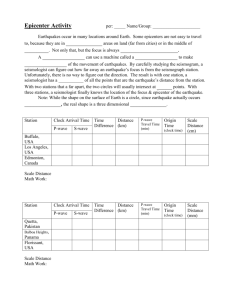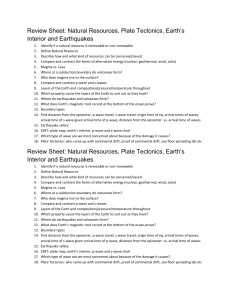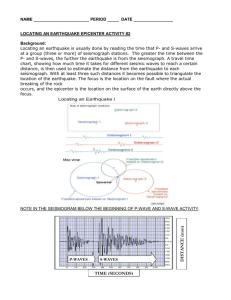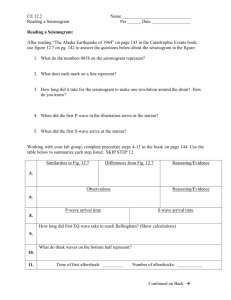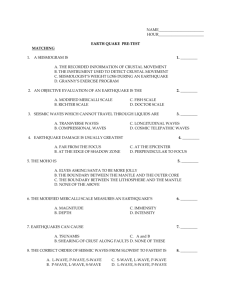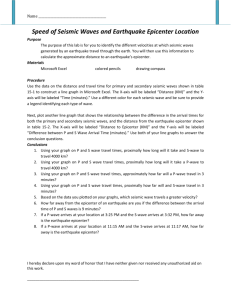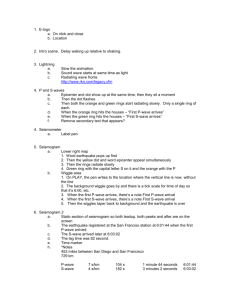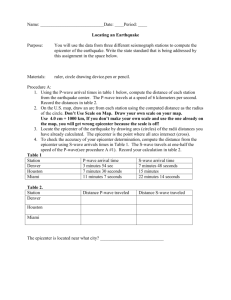Calculating Lag Time
advertisement
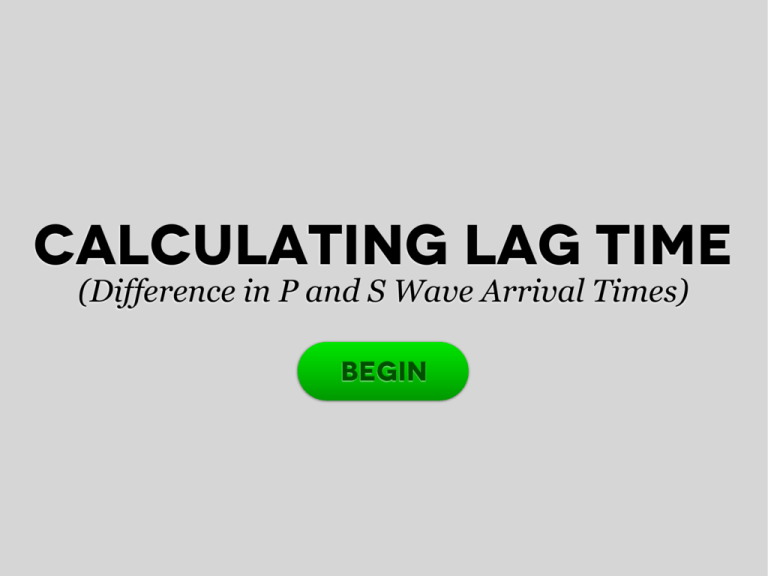
Calculating Lag Time (Difference in P and S Wave Arrival Times) begin (4) collision of crustal47 plate the rock layersand data table shown below. The cro Base your answers to questions andboundaries 48 on theincross section Time scale 0 1river2 flowing 3 4into 5the ocean. 6 7 The 8 arrows 9 10show 11 the 12direction 13 14 of15 ion shows a sediment-laden river flow. D (minutes Base your answers to qu zones ofBase sorted sediments, A, B, C, and D, have been labeled. Sediments have been taken from these zon after noon) your answer to question 43 on the seismogram below. The seismogram was recorded at a seismic recorded seismic waves from measured. data table showstimes the range of sediment sizes in each station The and shows the arrival of the first P-wave and S-wave fromzone. an earthquake. Seismogram #1 A River Zo ne 1 A B Ocean E F G H I Zone Bedrock P-wave arrival 8:06 a.m. 8:08 B J Zone XA 2 3 C D Ocean Zone CS-wave arrival Zone D 8:10 Major 1 Sediment Size 0.04 cm to 6 cm B 0.0062cm to 0.1 cm C 0.0004 cm to 0.006 cm D 8:14 Less 3than 0.0004 cm 8:16 8:12 Time 4 Data Table 4 48 The rock, siltstone, will mos 47 How is this pattern of horizontal sorting pro43 Which to the epicenter Z sedimentary 5 of the 5part of this seismogram is used to find the distance form from sediments deposited in zone duced? Y earthquake? (1) P-wave time, onlysettle more (1) A (1) High-density materials 6 (3) C 6 arrivalgenerally (2) B (4) D P-wave slowly. (2) S-wave arrival time, only 63 State one pos difference in the arrivalsettle time ofmore the P-wave and S-wave arrival (2) Rounded(3)sediments generally I 7 7 (4) difference in the height of the P-wave and S-wave bedrock dete slowly. (3) Dissolved minerals are generally deposited 8 8 diagram below is a seismogram of the famous San Francisco earthquake of 1906, recorded at a seisfirst. 64 Which type o station locatedparticles 6,400 kilometers fromdeposited San Francisco. (4) Bigger are generally first. II Continent 9 9 What is the lag time? .S./E. Sci.–Jan. ’04 last A B C D E [12]F G H I J 65 NEXT How long do seismograph? Seismogram #2 27 Which seismogram was recorded approximately 4,000 kilometers f Arrival of P-wave Arrival of S-wave 9 10 11 12 13 14 15 16 17 Arrival of P-wave 9 10 11 1 Time (min) T (1) What is the lag time? last Arrival of S-wave Arrival of NEXT P-wave Base your answers to questions 43 through 46 on the diagram and map below. The diagram shows th eismograms of the same earthquake recorded at three different seismic stations, X, Y, and Z. The distan B A coordinate system A om each seismic station toModel the earthquake epicenter have been drawn on Model the map. een placed on the map to describe locations. The map scale has not been included. 46 The difference in seismic station arrival tim 45 Model A best represents the motion of earthquake waves called Seismograms the two waves represented by the models h scientists determine the (1) P-waves (compressional waves) that travel S (1) amount of damage caused by an earthqu faster than S-waves P(shear waves) shown in (2) intensity of an earthquake model B Station X (3) distance to the epicenter of an earthquak (2) P-waves (compressional waves) that travel S bedrock (4) timelayer of occurrence theD? next earthquak slower41than S-waves (shear waves) shown in Approximately how many million years older than B is bedrock of layer P model B (1) 150 (3) 340 Station Y (3) S-waves (shear (2) 220waves) that travel faster than P(4) 420 waves (compressional waves) shown in modelSB P (4) S-waves (shear waves) that travel slower than 42 Evidence of tectonic activity in this cross section is provided by the Base your answers to questions Station Z P-waves (compressional waves) shown in Earth and its interior layers. Th (1) folding and tilting of the rock layers model B A through D are seismic stations o Noon Noon Seismogram #3 (2) faulting and movement of the rock layers Diagram 2 shows four seismo (3) igneous intrusion into the rock layers A, B, C, and D during the same tim (4) collision of crustal47 plate the rock layersand data table shown below. The cross Base your answers to questions andboundaries 48 on theincross section Time scale 0 1river2 flowing 3 4into 5the ocean. 6 7 The 8 arrows 9 10show 11 the 12direction 13 14 of15 tion shows a sediment-laden river flow. Diffe (minutes Base your answers to quest ofBase sorted sediments, A, B, C, and D, have been labeled. Sediments have been taken from these zones after noon) your answer to question 43 on the seismogram below. The seismogram was recorded at a seismic zones recorded seismic waves from an measured. data table showstimes the range of sediment sizes in each station The and shows the arrival of the first P-wave and S-wave fromzone. an earthquake. D E G H I Table WhatZ are AtheBlagCOcean times forF stations X, JY, Data and Z? River last on 1 eA 2 Ocean Zone XA B Major 1 Sediment Sizes 0.04 cm to 6NEXT cm 0.0062cm to 0.1 cm B be slowly. (3) Dissolved minerals are generally deposited 8 8 diagram below is a seismogram of the famous San Francisco earthquake of 1906, recorded first. 64 W station locatedparticles 6,400 kilometers fromdeposited San Francisco. (4) Bigger are generally first. Continent 9 9 Seismogram #4 .S./E. Sci.–Jan. ’04 A B 02:22:39 P-wave arrival C D E [12]F G H I J 65 H se 02:26:25 S-wave arrival [10] ./E. Sci.–Aug. ’02 ch time scale best represents the arrival-time difference between P-waves and S-waves at th What is the lag time? 0 P.S./E. Sci.–June ’10 P-wave arrival 0 last 4 Time (min) (1) 5 S-wave arrival 0 [13] P-wave arrival 0 P.S./E. Sci.–August ’10 5 Time (min) (3) 5 10 S-wave arrival NEXT Time (min) n) on of etters ations 4 15 16 17 (3) Seismogram #5 Arrival of P-wave Arrival of S-wave Deformed rock structure like this is most often caused (1) crustal plate collisions (3) extrus (2) deposition of sediments (4) glacia 9 10 11 12 13 14 15 16 17 n) Time (min) 25a The seismogram shows seismograph thatbelow shows the time that an earthquake P-wave arrived(at4 a) seismic station in mic station. Albany, New York. What is the lag time? denly decreases, last undergoes an 26 On each distance Which gradient 31 The satelliteArrival photograph below shows a NEXT geologic of P-wave of silt, sand, and clay. feature composed P-wave S-wave arrival one possible cause arrival 30 earthquake During the that Permian Period e of the resulted in Seismogram #6 I in the [1] Appalachian Region rock detected by this seismograph. temperature and pressure had existed in this environm at a seis- P-wave S-wave arrival 09:09:41 ich type of09:07:57 seismic wave was recorded first on the rotatin arrival have formed II (1) schist (2) gabbro w long does the first S-wave take to travel from the earth P-wave S-wave arrival mograph? [1] arrival P.S./E. Sci.–June ’04 What is the lag time? III P-wave arrival IV last NEXT at a seis- P-wave S-wave arrival ich type ofarrival seismic wave was recorded first on the rotatin have formed Seismogram #7 II (1) schist (2) gabbro w long does the first S-wave take to travel from the earth P-wave S-wave arrival 09:09:41 11:40:26 mograph? [1] arrival P.S./E. Sci.–June 11:47:31 ’04 III What is the lag IV station? last P-wave time? arrival [14] 49 No P (1) P NEXT Time (min) Tim (1) Seismogram #8 Arrival of S-wave Arrival of P-wave on the diagrams below. Diagram 1 represents a cross section of ( ) shows the location of an earthquake epicenter. Letters urface. eled I, II, III, and IV, which were recorded at seismic stations 9 10 11 12 13 14 15 16 17 Arrival of P-wave Deformed rock (1) crustal plate (2) deposition o 9 10 11 12 Time (min) Tim Earthquake 25a The seismogram below sh through 65 on the diagram below, which shows seismograph that epicenter ( seismic 2) earthquake P-wave arrived uake located 4000 kilometers from this station. A Albany, New York. What is the lag time? Diagram 1 Weight D 28 When the velocity of a stream suddenly decreases, Pen being transported undergoes an the sediment last increase in 31 The satellit feature com NEXT

